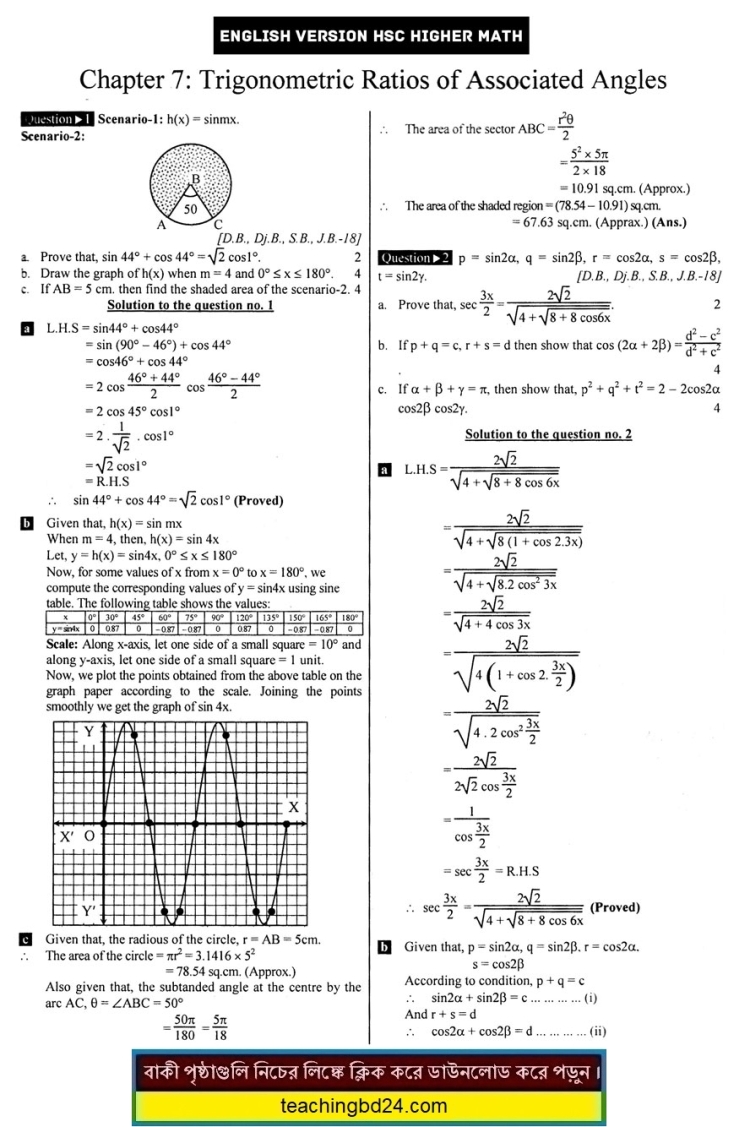HSC EV Higher Mathematics 1st Paper 7th Chapter Note
HSC EV Higher Mathematics 1st Paper 7th Chapter Note. Trigonometric Ratios of Associated Angles. In mathematics, the trigonometric functions are functions of an angle. They relate the angles of a triangle to the lengths of its sides. In mathematics, the trigonometric functions (also called circular functions, angle functions or goniometric functions) are functions of an angle. They relate the angles of a triangle to the lengths of its sides. Trigonometric functions are important in the study of triangles and modeling periodic phenomena, among many other applications. The most familiar trigonometric functions are the sine, cosine, and tangent. In the context of the standard unit circle (a circle with radius 1 unit), where a triangle is formed by a ray starting at the origin and making some angle with the x-axis, the sine of the angle gives the length of the y-component (the opposite to the angle or the rise) of the triangle, the cosine gives the length of the x-component (the adjacent of the angle or the run), and the tangent function gives the slope (y-component divided by the x-component).
HSC EV Higher Mathematics 1st Paper 7th Chapter Note. Trigonometric Ratios of Associated Angles


More precise definitions are detailed below. Trigonometric functions are commonly defined as ratios of two sides of a right triangle containing the angle, and can equivalently be defined as the lengths of various line segments from a unit circle. More modern definitions express them as infinite series or as solutions of certain differential equations, allowing their extension to arbitrary positive and negative values and even to complex numbers.
Trigonometric functions have a wide range of uses including computing unknown lengths and angles in triangles (often right triangles). In this use, trigonometric functions are used, for instance, in navigation, engineering, and physics. Common use in elementary physics is resolving a vector into Cartesian coordinates. The sine and cosine functions are also commonly used to model periodic function phenomena such as sound and light waves, the position and velocity of harmonic oscillators, sunlight intensity, and day length, and average temperature variations through the year.
Trigonometric functions have a wide range of uses including computing unknown lengths and angles in triangles (often right triangles). In this use, trigonometric functions are used, for instance, in navigation, engineering, and physics. Common use in elementary physics is resolving a vector into Cartesian coordinates. The sine and cosine functions are also commonly used to model periodic function phenomena such as sound and light waves, the position and velocity of harmonic oscillators, sunlight intensity, and day length, and average temperature variations through the year.
In mathematics, a combination is a selection of items from a collection, such that (unlike permutations) the order of selection does not matter. For example, given three fruits, say an apple, an orange, and a pear, there are three combinations of two that can be drawn from this set: an apple and a pear; an apple and an orange; or a pear and an orange. More formally, a k-combination of a set S is a subset of k distinct elements of S. If the set has n elements, the number of k-combinations is equal to the binomial coefficient.
Determinants occur throughout mathematics. For example, a matrix is often used to represent the coefficients in a system of linear equations, and the determinant can be used to solve those equations, although more efficient techniques are actually used, some of which are determinant-revealing and consist of computationally effective ways of computing the determinant itself. The use of determinants in calculus includes the Jacobian determinant in the change of variables rule for integrals of functions of several variables. Determinants are also used to define the characteristic polynomial of a matrix, which is essential for eigenvalue problems in linear algebra. In analytic geometry, determinants express the signed n-dimensional volumes of n-dimensional paralleled. Sometimes, determinants are used merely as a compact notation for expressions that would otherwise be unwieldy to write down. When the entries of the matrix are taken from a field (like the real or complex numbers), it can be proven that any matrix has a unique inverse if and only if its determinant is nonzero. Various other theorems can be proved as well, including that the determinant of a product of matrices is always equal to the product of determinants; and, the determinant of a Hermitian matrix is always real.
teachingbd24.com is such a website where you would get all kinds of necessary information regarding educational notes, suggestions and questions’ patterns of school, college, and madrasahs. Particularly you will get here special notes of physics that will be immensely useful to both students and teachers. The builder of the website is Mr. Md. Shah Jamal Who has been serving for 30 years as an Asst. Professor of BAF Shaheen College Dhaka. He expects that this website will meet up all the needs of Bengali version learners /students. He has requested both concerned students and teachers to spread this website home and abroad.
